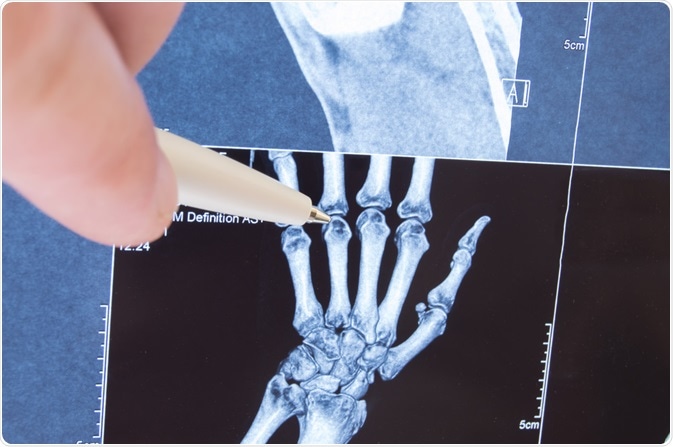Juvenile idiopathic arthritis (JIA) refers to any of a group of conditions that are associated with joint inflammation first occurring before the person is 16 years of age.
Several types are known, classified by:
- Their signs and symptoms
- Number of affected joints
- Laboratory results
- Family history
 Image Credit: Shidlovski/Shutterstock.com
Image Credit: Shidlovski/Shutterstock.com
Causes of juvenile idiopathic arthritis
Juvenile idiopathic arthritis is an autoimmune condition. The synovial membrane that lines the affected joint is eaten away by inflammatory injury caused by antibodies directed against the body’s own antigens (autoantibodies).
Juvenile idiopathic arthritis is due to a combination of genetic and environmental factors. Some variations in certain genes associated with the immune reaction of the individual, called the HLA complex, are known to be linked to a higher incidence of the disease. Infection, inflammation, and disease are also thought to precipitate the disorder in predisposed individuals.
Few people with JIA report a family history of the disease, but the risk of developing JIA is 12 times higher for siblings of an affected person compared to the general population.
Signs and symptoms of juvenile idiopathic arthritis
The main symptoms of juvenile idiopathic arthritis relate to inflammation. Features of joint inflammation include:
- A red, painful, and swollen joint
- Stiffness and limitation of joint movement
- Limping gait, especially in the morning
- Pain on moving a joint
- Persistent low back ache
Systemic symptoms
Systemic symptoms include:
- Lymphadenopathy
- Malaise
- Pallor
- An ill-looking patient
Eye symptoms
Eye symptoms associated with JIA:
These are due to uveitis, inflammation of the colored membrane that lines the inside of the eyeball. It may manifest as:
- Redness of the eyes
- Pain of the eyeballs
- Irritation of the eyes on looking at light, which is called photophobia
- Changes in visual acuity
Clinical features of specific types
Specific types may show the following symptoms and signs:
Systemic juvenile idiopathic arthritis
High fever appears every day over a period of at least 2 weeks, either before or simultaneously with the onset of the joint inflammation. The inflamed joint is red, swollen, warm, and tender. A skin rash may coincide with fevers. Lymphadenopathy and hepatosplenomegaly are other associated findings.
Oligoarticular juvenile idiopathic arthritis
In oligoarticular JIA, joint pain is the only symptom. Four or fewer joints are affected during the first six months following onset. Two subtypes have been described:
- Persistent oligoarthritis: four or fewer joints are affected even after the first six months.
- Extended oligoarthritis: more than four joints are affected after six months have passed from the onset.
Rheumatoid factor-positive polyarticular juvenile idiopathic arthritis
In this form, five or more joints are affected within the first six months and the blood test for rheumatoid factor is positive. This type closely resembles adult rheumatoid arthritis. The joints affected may be those of the limbs, neck, or jaw.
Rheumatoid factor negative polyarticular juvenile idiopathic arthritis
It resembles the above but is negative for rheumatoid factor. The wrists and knees are the most frequently affected joints. Eye involvement is most common with this form.
Psoriatic juvenile idiopathic arthritis
In this condition, JIA is accompanied by a skin disease called psoriasis, which shows patches of red raw-looking skin covered by white flaking skin. The order in which the two conditions develop varies between individuals. Nail and eye changes may occur with this form of JIA.
Enthesitis-related juvenile idiopathic arthritis
In this form of JIA the joint inflammation is associated with spots of tenderness, which are located where tendons and ligaments attach to bone. Other parts of the body may also develop inflammatory changes.
Undifferentiated arthritis
When features of more than one type are present, or if none of the characteristic features of any type are present, the patient is said to have undifferentiated arthritis.
Juvenile Idiopathic Artheritis
References
Further Reading
Last Updated: Mar 24, 2021